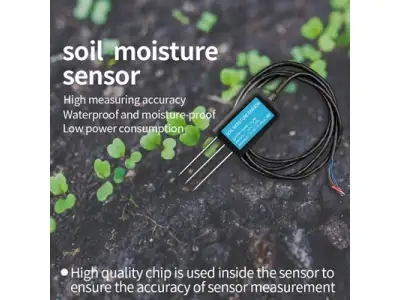
What are the soil sensors
The soil nitrogen, phosphorus and potassium sensor can detect the content of nitrogen, phosphorus and potassium in the soil to provide essential nutrients for plants and promote plant growth.

The soil nitrogen, phosphorus and potassium sensor can detect the content of nitrogen, phosphorus and potassium in the soil to provide essential nutrients for plants and promote plant growth.
Soil is the main material basis for plants to survive. It can provide crops with the necessary water, fertilizer, heat, and air for their growth. This is mainly because the composition of soil includes organic matter, minerals, soil air and soil moisture, microorganisms, etc. , Minerals are the most basic substances, which can provide a variety of nutrients to plants. Organic matter can not only provide nutrients to plants, but also play a very important role in improving soil aggregate structure and physical and chemical properties, as well as water supply, water retention, temperature stabilization, and ventilation. What parameters can the soil sensor soil detector detect and what function does it have?

Soil moisture is low, which will directly (decrease photosynthetic raw materials) or indirectly (stomatal closure, enzyme inactivation, etc.) affect the decline of photosynthesis, becoming a major limiting factor for photosynthesis. The lack of water can also cause the death of crops, because the total volume of the soil gap is certain, and this part of the volume is occupied by water and air. So when there is too little water, the plant roots will not absorb enough water, and the plant's transpiration will cause the plant to lose a lot of water, which will cause the plant to lose its wilt. The root system is pulled and broken, causing plant death in severe cases. When there is too much water, the proportion of air is small, resulting in weakening of aerobic respiration of plant roots, and plant roots are forced to turn to anaerobic respiration. Anaerobic respiration produces alcohol poisoning plant roots, causing root rot, and in severe cases, plant death.
To monitor soil moisture, a soil moisture sensor can be used to determine whether to irrigate or whether to stop irrigation based on the data to ensure that the soil moisture is suitable for crop growth.
A suitable soil temperature is conducive to the growth of plants, and too low or too high a temperature is not conducive to the growth of plants. Crop seeds must germinate within a suitable soil temperature range. Within a certain temperature range, the higher the soil temperature, the faster the growth and development of crops, and the growth of different plants has different requirements for temperature.
The soil temperature is monitored by the soil temperature and humidity sensor, so that the soil temperature is maintained within the suitable growth temperature range of the crops, and the increase in crop production and income is ensured.
All kinds of plants have their own suitable soil acidity and alkalinity for their growth. Most plants are difficult to grow normally when the pH is too high or too low. Some diseases can only occur within a certain pH range, such as damping-off, which tends to occur on alkaline and neutral soils. The pH sensor of the soil is used to detect the pH of the soil. The appropriate pH of the soil can help increase the step length of agricultural products and reduce the pests of diseased products. Therefore, the monitoring of soil pH is very necessary.
Nitrogen is the main component of protein, which plays an important role in the growth of stems and leaves and the development of fruits, and is the nutrient element most closely related to yield. Before the first panicle rapidly swells, the plant's absorption of nitrogen gradually increases.
Phosphate fertilizer can promote tomato flower bud differentiation, early flowering and fruiting, promote seedling root growth and improve fruit quality. When phosphorus is deficient, the young shoots and roots grow slowly, the plants are short, the leaves are dark green, dull, and the back is purple.
Potassium can promote healthy plant stems, improve fruit quality, enhance plant cold resistance, increase fruit sugar and vitamin C content, as in the case of nitrogen and phosphorus, potassium deficiency symptoms first appear in old leaves. When the potassium supply is insufficient, carbohydrate metabolism is disturbed, photosynthesis is inhibited, and respiration is strengthened. Therefore, when potassium is lacking, the plant's resistance to stress is weakened, and the plant is vulnerable to disease, the fruit quality is reduced, and the coloring is poor.
The soil nitrogen, phosphorus and potassium sensor can detect the content of nitrogen, phosphorus and potassium in the soil to provide essential nutrients for plants and promote plant growth.